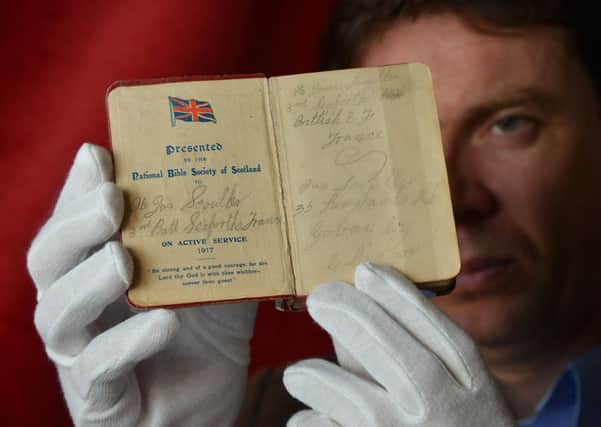Dying Scot soldier’s bible in WWI exhibition


For the German soldier who took the memento as he comforted his opponent, the Bible became a token of reconciliation from the First World War that he would go on to treasure.
But 20 years later, with the threat of another global conflict looming, Erich Altrogge decided it was time for the family of Private James Scouller to be reunited with the tiny version of the New Testament.
Advertisement
Hide AdNow the Bible, which is inscribed with his name, and the letter sent from Germany to the family of the Paisley-born soldier, who died on the Western Front in France have been given pride of a place in a major new exhibition of First World War memorabilia.
The Bible is just one of dozens of treasured momentos drawn together for the first time for a moving new display at Edinburgh Castle, which has been assembled to coincide with the 100th anniversary of the conflict later this year.
The letter describes in moving terms the impact his death had on his German opponent, who wrote to the family to explain how he spent several hours with him and that the precious time would stay with him “till my end of life.”
Other souvenirs saved from the heat of battle include a piece of shrapnel kept by a soldier who had his leg amputated shortly before dying from injuries sustained in a trench at Ypres, a shell fished out of the sea after a near miss at Anzac, in Gallipoli, and a German-made bayonet seized from a Turkish soldier during the capture of Wadi El Hesi in Palestine.
But the exhibition at Scotland’s National War Museum, which largely focuses on the impact of the war on eight Scottish families, also features a host of unusual material and memorabilia collected by soldiers who survived and the relatives of those who never returned home.
Among the highlights are a model tank made by a German Prisoner of War, bought by a Scottish engineer, Archibald Sneddon, before he was called up for the war himself and taken with him to America after he survived the conflict and emigrated in 1923.
Advertisement
Hide AdThe exhibition features two books of autographs, drawings, jokes and messages from soldiers collected by Florence Mellor, a nurse working at Craiglockhart War Hospital in Edinburgh, which dealt with victims of “shell shock” and a memorial plaque and scroll sent to her family when her brother Hayden was killed serving in France in 1918.
There are various momentos relating to Private Andrew Baillie, one of the victims of the Gretna Rail Disaster in 1915, when a troop train carrying soldiers from Leith was involved in a multiple crash, including a Royal Scots cap badge recovered from the wreckage by his brother John.
Advertisement
Hide AdThe exhibition will be running at the castle from today until next March before going on to tour around Scotland to Dumfries, Ayr, Hawick, in the Borders, Hamilton, in Lanarkshire, Alford in Aberdeenshire, Inverness, Thurso, Perth and Orkney.
Dr Stuart Allan, principal curator of Scottish history at National Museums Scotland, which runs the castle attraction, said the core exhibition would be supplemented by exhibits linked to each area as it travels around over the next three years.
He told The Scotsman: “We really wanted to reflect all the different things that people kept and also show what they meant in the context of a family story.
“People generally hold onto these kind of possessions because they mean so much to them. We have the odd item from the First World War on display in our permanent collections, but I don’t think any of this has been on display before and this is definitely the first time it’s all been brought together like this.
“Obviously the objects that are most powerful have belonged to someone who has been killed in the war, but that gives a slightly skewed idea that no-one survived. We were conscious of the need to reflect the different types of experience people had.”
The war museum exhibition is one of two major showcases of First World War memorabilia being staged by NMS this year, with the Scottish Government and Heritage Lottery Fund helping to pay for them.
Advertisement
Hide AdThe other major exhibition, Common Cause, which will run from July-October, will explore the war stories of the Scottish diaspora, with displays to be drawn from collections around the Commonwealth.
Colin McLean, head of the HLF in Scotland, said of the castle exhibition: “Objects which were once kept as a way of remembering individual loved ones have been brought together so we can all remember the impact the war had on families and communities across Scotland.
Advertisement
Hide Ad“As it travels the country, people will have the opportunity to add their own story to this exhibition making sure that their heritage is safeguarded for future generations while giving us a deeper understanding of the conflict.”